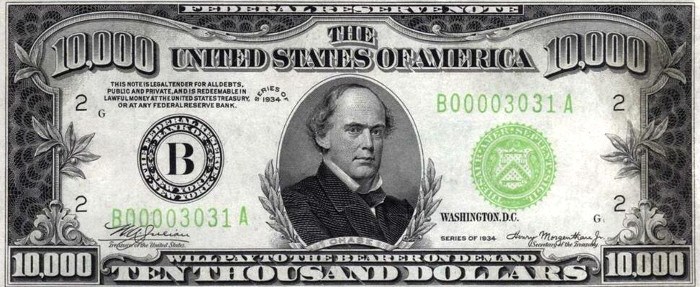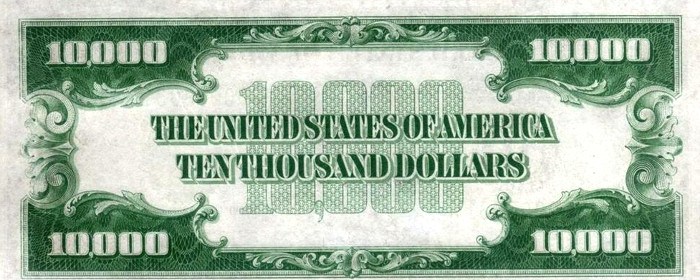The 10,000 dollar bill was the largest sized bill ever issued to the American public. It's a real bill but the public rarely ever saw one because they were used exclusively for bank transfers and other large transactions. Needless to say, this bill was rare back then and it's extremely rare now.
There were several different series issued but most of them have been either redeemed or placed in museums. Below we are only going to examine the most common $10,000 bill series: the 1928 and 1934 Federal Reserve notes. The US government printed a combined 60,000 bills for these two years. But today only 336 are known to exist.
There are no star notes for either the 1928 or 1934 series. But the US government did print some replacement bills which have light colored ink instead of dark colored ink. The light colored notes don't sell for a premium because every single $10,000 bill is already extremely rare and desirable.
Who Is on the 10,000 Dollar Bill?
Salmon P Chase is the man pictured on the most common ten-thousand dollar bill series. Therefore he is considered to be the "the face" of the ten-thousand dollar bill. So who was Salmon P. Chase? He was a politician, a former Chief Justice of the United States, and a former Secretary of the Treasury. At the time he was Secretary of the Treasury the government was planning to introduce new currency in 1861. Chase choose himself to be on the front of the 10,000 dollar bill.
There are also gold certificates that featured President Andrew Jackson but all but a few of those bills have been redeemed.
Value
These bills will be worth tens of thousands of dollars in any condition. But since these bills were sparingly used, most of them still in existence are in great condition. Below we will review a few of the different series that are occasionally sold at auction.
1928 $10,000 Federal Reserve Note
There are only eight 1928 series $10,000 Federal Reserve notes known to exist today, and two of them are in museums.
The 1928 $10,000 notes issued from the Federal Reserve Bank of Cleveland are worth around $175,000 in very fine condition. In extremely fine condition the value is around $275,000. In uncirculated condition the price is around $350,000 for notes with an MS 63 grade.
The 1928 $10,000 notes issued from the Federal Reserve Bank of Richmond are worth around $175,000 in very fine condition. In extremely fine condition the value is around $250,000. In uncirculated condition the price is around $650,000 for notes with an MS 63 grade.
1934 $10,000 Federal Reserve Note


There are about 328 known 1934 series $10,000 Federal Reserve notes in existence today, and most of them were once apart of the Binion Hoard. The Binion Hoard refers to Ted Binion's collection of coins and currency. Ted Binion was a wealthy casino owner who loved to collect and show off his dollar coins and paper currency. He once had one-hundred $10,000 bills glued to a display board at his Las Vegas casino.
Most of the notes from the Binion Hoard have minor defects from being removed from the display. However the notes still command a high grade.
Most 1934 $10,000 notes are worth around $125,000 in very fine condition. In extremely fine condition the value is around $185,000. In uncirculated condition the price is around $275,000-300,000 for notes with an MS 63 grade. Notes issued from the Federal Reserve Bank of Boston are more valuable.
Grading System
Very fine- A note that has been in circulation but not for a long time. The note is still relatively crisp. There may be some creases, folds, or light smudges.
Extremely fine- A note that shows small signs of having been in circulation. The note will be bright and it will have almost all of its original crispness. There might be one or two minor creases or folds but there are no stains, discolorations, or tears.
MS 63 choice uncirculated- A note that shows no signs of ever having been in circulation. The note still has its original crispness. The note is also well-centered.
Conclusion
A $10,000 bill is extremely rare and thus will be valuable in any condition. It was the largest bill ever in circulation but it wasn't the largest bill printed by the US government. In 1934 the US government printed the $100,000 bill although it was never released to the public. Instead it was just used exclusively by banks to make large transfers.
Sources:
A Guide Book of United States Paper Money
See also:
